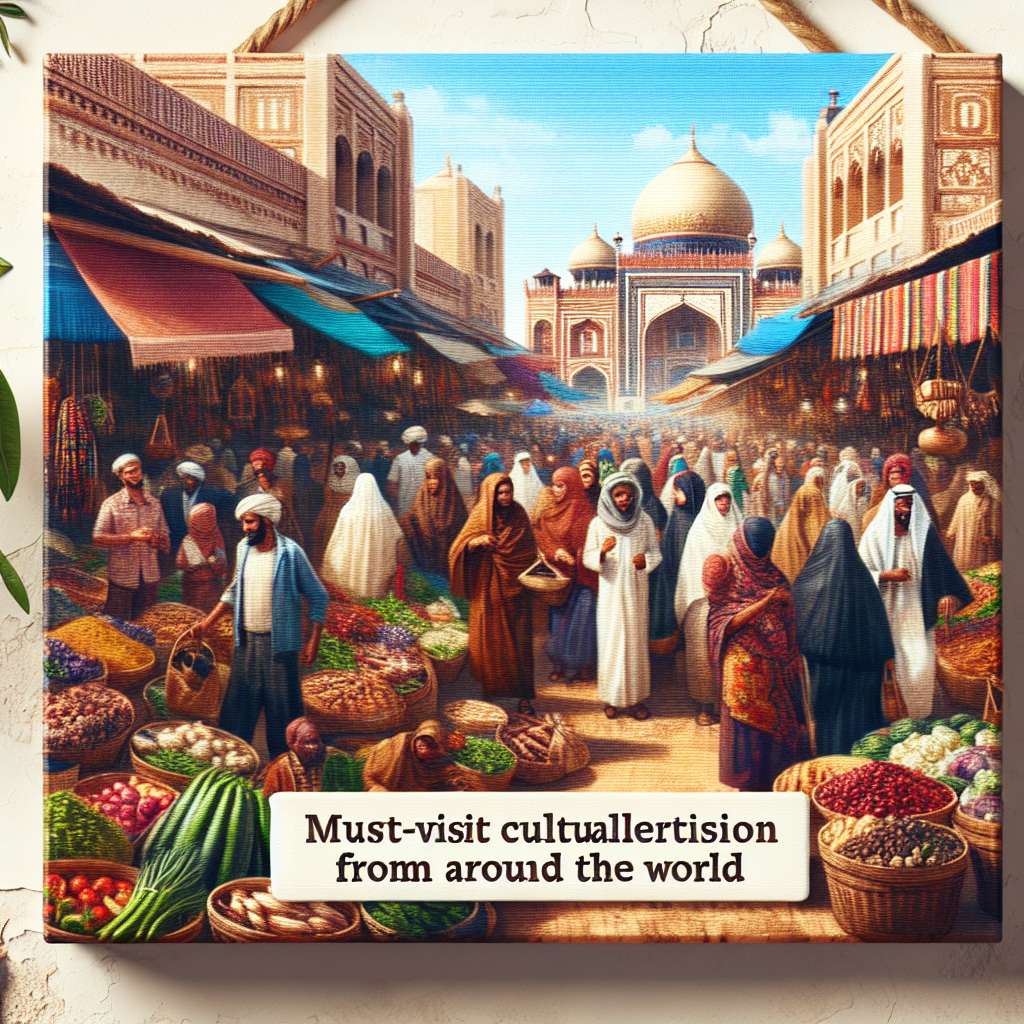
#ez-toc-container {
background: #f9f9f9;
border: 1px solid #aaa;
border-radius: 4px;
-webkit-box-shadow: 0 1px 1px rgba(0, 0, 0, .05);
box-shadow: 0 1px 1px rgba(0, 0, 0, .05);
display: table;
margin-bottom: 1em;
padding: 10px 20px 10px 10px;
position: relative;
width: auto;
}
.ez-toc-container-direction {
direction: ltr;
}
.ez-toc-list-level-1 a{
font-weight:bold;
}
Table of Contents
1. Introduction to Cultural Immersion through Markets
Cultural immersion represents the heart and soul of travel for the more discerning explorer. It goes beyond ticking landmarks off a list; it’s about diving headfirst into the essence of a place, engaging with its traditions, and conversing with its people. In a globalized world, the significance of cultural immersion is amplified, allowing travelers to foster understanding, empathy, and connection across diverse cultures. One of the most authentic pathways to achieve this immersion is through local markets.
Local markets are vibrant microcosms where the pulse of daily life can be felt in its most genuine form. They act as gateways into the heart of communities, offering travelers firsthand experiences that are as rich as they are memorable. From the bustling bazaars of Marrakech to the aromatic food stalls of Bangkok, markets worldwide serve as the nexus of cultural exchange, providing an unfiltered look into the nuances of everyday life.
Markets are not merely places of commerce but are cultural landmarks that reflect the local cuisine, crafts, and social habits. Each stall tells a story, every vendor a potential guide into understanding the regional heritage. As travelers navigate the aisles, they are met with vibrant displays of fresh produce, meticulously crafted goods, and an array of local delicacies that are as unique as the cultures they represent.
Moreover, local markets provide an unparalleled opportunity to witness the artistry and craftsmanship that locals have preserved and perfected over generations. Whether it’s intricate textiles in a Peruvian market or hand-thrown pottery in a Greek one, each piece embodies the history and skills passed down through eras. Through these encounters, travelers gain insights into cultural practices and values that define and shape the local communities.
Engaging with markets as a cultural immersion tool is not merely anecdotal but supported by numerous studies and traveler testimonials. According to a survey by the World Travel & Tourism Council,
- 78% of travelers believe that experiencing local culture significantly enhances their trip satisfaction.
A quote from seasoned traveler Sarah Lee reads, “Wandering through local markets was like flipping through the pages of a city’s daily diary.” These reflections resonate with countless others who have discovered the powerful role markets play in enriching their travel experience.
To capture the interest of travelers seeking genuine cultural experiences:
- Discover the culinary delights and staple foods that form the backbone of local diets. Engage with vendors who take pride in their produce and learn about the culinary traditions that define their region.
- Find unique and handcrafted souvenirs that tell a story far more compelling than mass-produced trinkets.
- Observe social interactions and participate in the communal life of the market, gaining an understanding of societal norms and values.
- Immerse yourself in sensory experiences — the sights, sounds, and scents that offer a richer understanding of the locale.
The value of markets in cultural immersion extends beyond their economic aspect, reflecting the intersection of history, identity, and community pride. Through markets, we are invited to transcend the role of mere spectators and become active participants in the cultural tapestry of the places we visit. They offer us an open door to step into lives and environments wholly different from our own, fostering a deeper appreciation and broader perspective of the world around us.
In conclusion, as more travelers seek meaningful connections over superficial adventures, cultural immersion through local markets stands out as an invaluable experience. These vibrant hubs of activity encapsulate the spirit of cultures in all their authenticity and complexity, inviting us to explore, learn, and connect. As the saying goes, “When in doubt, visit the market.” It’s here that the heart of any culture beats strongest, waiting to be discovered.

2. Asian Markets: A Sensory Overload
Traveling through Asia’s bustling markets is an experience like no other—it’s a sensory overload that leaves travelers spellbound. From the vibrant hues of exotic spices to the tantalizing aroma of street food, each market offers a unique atmosphere that is both captivating and overwhelming. Among the most renowned markets, Bangkok’s Chatuchak Weekend Market and Tokyo’s Tsukiji Fish Market are must-visit destinations for any traveler looking to dive into the heart of Asian culture. In this guide, we’ll take you on a journey through these lively markets, highlight their unique offerings, and provide essential tips for making the most of your visit.
Chatuchak Weekend Market, Bangkok
Known as one of the largest markets in the world, Chatuchak Weekend Market in Bangkok is a maze of over 15,000 stalls selling everything from clothing and artwork to antiques and fresh food. Open only on weekends, this enormous market attracts over 200,000 visitors each weekend.
- Unique Offerings: Chatuchak is famous for its vast selection of Thai spices, handmade crafts, and one-of-a-kind souvenirs.
- Street Food: The market is a paradise for foodies. Savor delicious Papaya Salad, or indulge in classic Thai Iced Tea.
Tips for Navigating
- Download a map of the market before you go. This will help you locate specific sections and stalls of interest.
- Wear comfortable clothing and stay hydrated. The market’s vast size can make for a long day of walking.
- Practice haggling, as bargaining is common and expected.
Tsukiji Fish Market, Tokyo
Though the Tsukiji Inner Market has moved to Toyosu, the Tsukiji Outer Market remains a vibrant hub of activity. This market is perfect for those looking to experience firsthand the bustling world of Tokyo’s culinary delights.
- Unique Offerings: Known for the freshest fish and seafood, Tsukiji offers unparalleled sushi and sashimi experiences.
- Street Food: Try some grilled seafood skewers or a bowl of chirashi don as you explore the sights.
Cultural Etiquette
- Respect the vendors and their business. Always ask before taking photographs.
- Visit early in the day for the best selection of goods and food.
- Dispose of waste properly in designated areas. Cleanliness is valued highly in Japan.
Traveler Testimonials
Here are stories from past visitors who have absorbed the colorful chaos of these Asian markets:
Emily from Australia: “The Chatuchak Market was a highlight of my Bangkok trip! I found unique pieces of art and the best Pad Thai I’ve ever tasted. The sheer size of the market was mind-blowing.”
Liam from Canada: “Wandering Tsukiji was a dream come true. I was able to try the freshest sushi right at the source. The vitality and freshness of the ingredients are something I’ve never experienced back home.”
These testimonials reflect the unforgettable impact that Asian markets have on their visitors. By embracing the sensory overload, travelers emerge with richer experiences and cherished memories.
Whether you’re drawn by the fragrant spices, the enticing street food, or simply the vibrant hustle and bustle, the markets of Asia promise an adventure like no other. Use this guide to navigate these mesmerizing locales, respect cultural nuances, and fully immerse yourself in the lively spirit that defines these iconic markets. Happy travels!

3. European Charm: Timeless Markets to Explore
Europe is famed for its enchanting amalgamation of bustling cities, rich history, and quaint traditions. One of the most captivating ways to experience this charm is through its timeless markets, where history, architecture, and culinary diversity intertwine seamlessly. In this segment, we journey through two iconic European markets: Barcelona’s La Boqueria and London’s Borough Market, exploring their vibrant past, stunning architecture, and delightful delicacies that are a feast for both the eyes and the palate.
Barcelona’s La Boqueria: A Feast for the Senses
Located in the heart of Barcelona, La Boqueria is more than just a market; it is a sensory journey into the very essence of Catalonia. Established in 1217, the market has been a staple of Barcelona’s culinary scene for centuries. As you step into La Boqueria, you are greeted with a riot of colors, scents, and sounds, each stall offering a slice of Spanish culture and tradition.
- History and Architecture: The history of La Boqueria is as rich as the offerings found within. Originally a place for local farmers to sell their meat, the market has evolved over the years into a vibrant center for gastronomic delights. The grand wrought-iron entrance leads into a sprawling space that retains its historical charm while embracing modern enhancements. The iconic stained glass that frames the entrance is a nod to Catalonia’s artistic flair and adds a touch of elegance to this bustling hub.
- Diverse Culinary Experiences: La Boqueria is a culinary playground. From freshly caught seafood and exquisite meats to vibrant fruits and tantalizing pastries, the market is a treasure trove of flavors. The Catalonian penchant for quality and freshness is evident in every carefully curated display. As you wander through, stop by an outlet for freshly made tapas, offering a taste of Spain’s quintessential social dining experience.
Must-Try Local Delicacies
When in La Boqueria, certain delights are not to be missed:
- Jamón Ibérico: This is Spain’s prized ham, renowned for its rich, nutty flavor and silky texture. Made from Iberian pigs, the ham is meticulously cured, offering a melt-in-the-mouth experience.
- Paella: A visit to La Boqueria is incomplete without indulging in a traditional paella. Bursting with flavors of saffron, seafood, and perfectly cooked rice, this dish encapsulates the vibrant spirit of Spanish cuisine.
- Churros with Chocolate: Treat yourself to crispy churros paired with a rich, decadent chocolate sauce — a sweet indulgence that is quintessentially Spanish.
The cultural significance of La Boqueria transcends its culinary offerings. It serves as a testament to the Catalonian spirit of community, where locals and tourists alike gather to celebrate food, culture, and tradition.
London’s Borough Market: A Heritage of Flavors
Steeped in history and nestled in the heart of London, Borough Market is a beloved institution and a melting pot of cultures and cuisines. Its roots date back to at least the 12th century, making it one of the oldest and most renowned food markets in the United Kingdom.
- History and Architecture: Borough Market’s storied past is reflected in its inviting architecture. The elegant iron and glass design of the current market building were constructed in the late 19th century and have been lovingly preserved. Wandering beneath the Victorian arches is akin to stepping back in time, with every corner of the market reminiscent of a bygone era.
- Diverse Culinary Experiences: A stroll through Borough Market reveals a culinary wonderland. The market’s offerings represent a global banquet, featuring everything from artisanal cheese and freshly baked bread to charcuterie from across the Channel and spices from far-flung regions. The aroma of street food beckons visitors to explore different flavors and traditions, perfectly capturing London’s multicultural essence.
Must-Try Local Delicacies
Borough Market invites visitors to delve into its eclectic offerings with these standout choices:
- Artisanal Cheese: The market is a haven for cheese enthusiasts, with a remarkable variety of artisanal cheeses from across the UK and Europe. Sampling the rich, tangy offerings is an experience in itself.
- Scottish Eggs: A British classic perfected at Borough, these consist of seasoned sausage meat encasing an egg, all breaded and deep-fried to golden perfection.
- Pork Pies: These crusty delights, filled with seasoned pork, are a must-try for anyone seeking a taste of traditional British cuisine.
Borough Market does more than just tantalize the taste buds; it underscores the city’s historical embrace of diversity and innovation. Each stall is a nod to London’s enduring ability to blend tradition with modernity, making it not just a market, but a vibrant community hub.
In essence, exploring La Boqueria and Borough Market is diving headfirst into the rich cultural tapestry of Europe. Each market, with its own distinct history and flavors, offers a unique opportunity to witness the living heritage of its respective city. Whether you’re a culinary connoisseur or a curious traveler, these timeless markets promise an unforgettable journey into the heart of European charm.
4. Vibrant Markets of the Americas
Exploring the vibrant markets of the Americas is an adventure that leads you to the heart of local culture and tradition. From the bustling aisles of Mexico City’s Mercado de la Merced to the colorful stalls of Quito’s Otavalo Market, each offers a unique glimpse into the everyday lives of its community. These marketplaces are not just places to buy goods; they are cultural bastions that preserve indigenous crafts, handmade textiles, and local produce, offering an immersive experience for every visitor.
Mexico City’s Mercado de la Merced, one of the largest markets in Latin America, is a sensory overload where vendors offer everything from fresh produce to traditional Mexican sweets. Stepping into its labyrinth of aisles, visitors are greeted by the vibrant colors of chillies, the fragrant aroma of herbs, and the lively banter of merchants. This market plays a crucial role in community life, serving as a central hub where urban and rural cultures converge.
Quito’s Otavalo Market in Ecuador, on the other hand, is renowned for its indigenous crafts and textiles. Situated in the heart of the Andean region, Otavalo Market is a testament to the rich heritage of the Otavaleños. Here, skilled artisans display an array of handmade products, from intricate weavings to elaborate jewelry, each piece telling a story of cultural significance.
The Role of Markets in Community Life
Markets in North and South America are often much more than commercial venues—they are social spaces that foster community interactions and exchange of ideas. In the Mercado de la Merced, for instance, it is common to hear patrons discussing the best way to prepare local dishes, while children play under the watchful eyes of their parents. The market has historically been a place where people from differing social backgrounds meet, bridging gaps through the communal love of food and tradition.
Similarly, Otavalo Market acts as a vital social hub for the indigenous communities of Ecuador. On Saturdays, the market expands to host more vendors and visitors who come to experience the spirited atmosphere and partake in cultural exchanges. It is not only a place for commerce but also a living museum where customs and practices are passed down through generations.
Indigenous Crafts and Handmade Textiles
The artistry found in the markets of the Americas is unparalleled. Craftsmen and women at Otavalo Market are famous for their skill in tapestry and garment creation. Using traditional methods, these artisans weave vibrant wool textiles featuring geometric patterns and symbols that are deeply woven into their cultural identity. Each item is a piece of living history, crafted from techniques that have been preserved over centuries.
Meanwhile, at Mercado de la Merced, visitors can find unique artisan goods like Talavera pottery, papel picado, and handcrafted toys. The craftsmanship here is varied, with items representing various regions of Mexico. Whether you are buying a handmade textile or observing artisans at work, engaging with these crafts brings you closer to understanding the cultural depths of these communities.
Local Produce and Culinary Delights
The markets are also renowned for their delectable offerings. In Mercado de la Merced, the array of fresh produce is staggering—piles of ripe avocados, juicy citrus fruits, and aromatic spices line the stalls. Food lovers can indulge in local delicacies, from tacos filled with tender carnitas to the sweet and spicy notes of mole.
Otavalo Market also tantalizes the senses with its selection of local foods. Traditional Ecuadorian dishes such as llapingachos and empanadas can be enjoyed amidst the backdrop of Andean music. Tasting these dishes offers a traditional culinary experience, drawing you into the rich flavors of the region.
Recommendations for Engaging with Local Vendors
- Learn Basic Phrases: A few words in Spanish or the local indigenous language can go a long way. Simple greetings and expressions of gratitude can deepen your interaction and show respect for the culture.
- Ask About the Craft: Vendors are often more than happy to share the story behind their goods. Listen to these narratives to appreciate the item’s cultural background.
- Haggle Respectfully: Bargaining is a common practice, especially in Otavalo Market. Engage with vendors in a respectful manner, valuing the time and skill put into each craft.
- Support Ethical Purchases: Ensure that your purchase supports the local economy and sustains the traditional craft methods by buying directly from artisans.
Participating in Cultural Exchanges
Visiting these markets offers an opportunity for cultural exchange that goes beyond mere transactions. Participate in local customs, from sharing meals to attending traditional performances organized in and around the marketplace. By doing so, you not only enrich your own experience but also contribute to the preservation of these vibrant cultural scenes.
- Attend Local Festivals: Often, markets are at the center of local festivities. Plan your visit to coincide with these events to witness traditional dances, music, and crafts in full display.
- Join Workshops: Many markets offer workshops where tourists can learn indigenous crafting techniques directly from skilled artisans. These sessions provide a hands-on connection to the culture.
- Share Your Culture: Engage in conversations that allow for a mutual exchange of cultural ideas and practices, fostering a deeper understanding and respect.
The marketplaces of the Americas are teeming with life, history, and culture, offering an authentic snapshot of local traditions and values. Whether you’re meandering through Mercado de la Merced or exploring Otavalo Market, the opportunity to engage with these vibrant spaces and their custodians is an invaluable experience. Approach your visit with curiosity, respect, and an openness to learn, and you will gain more than just souvenirs—you’ll acquire treasured memories and a deeper appreciation for the rich cultural tapestry of the Americas.


